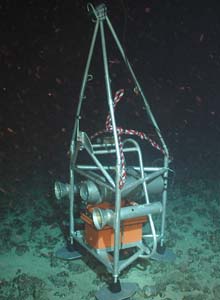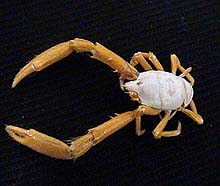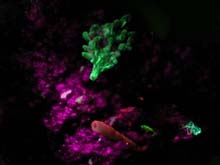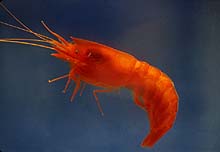
Figure 1: Eye-in-the-Sea, an unobtrusive deep-sea observatory system that uses red-light illumination and an intensified video camera. Click image for more information and larger view.
Operation Deep Scope: Mission Plan
Edith Widder
Senior Scientist
Harbor Branch Oceanographic Institution
Scientists observe, categorize, and count the life on land with relative ease. Performing these tasks in the ocean’s depths, however, poses daunting challenges, including the darkness and our inability to see without light. The methods we use to research the deep ocean can create obstacles, as well. Sampling with nets and brief visits with submersibles and remotely operated vehicles (ROVs) have significant limitations. Bottom trawling nets can damage animals and destroy habitats, and may grossly underestimate the number of animals present. Submersibles and ROVs use noisy thrusters and bright lights that undoubtedly frighten off animals and certainly disturb their behaviors.
Operation Deep Scope takes a fresh approach. Recent advances in underwater imaging and optical system design have opened up an exciting new frontier for ocean exploration -- and this mission uses these new technologies. Our mission's main goal was set forth at the 2000 President’s Panel for Ocean Exploration: to “see the oceans through a new set of technological ‘eyes.’” In other words, we will use advanced, unobtrusive technologies to see animals and behaviors never before witnessed by humans. Our team consists of international experts in optical oceanography and visual ecology. We intend to apply their expertise to explore some very unusual and diverse habitats in the Gulf of Mexico.
Another aspect of this mission is that our target dive sites are in a region of escalating gas and oil exploitation. These studies will provide a better understanding of these rich biological communities, which is essential for their proper management and protection.

Figure 2: This crab, Galathea rostrata, has a carapace that blends well with the sand, but its legs don't bend. Instead of seeing a crab, you see a "collection of bent dark sticks." Click image for larger view.
Target Sites
Our 10-day exploration in the Gulf of Mexico focuses on four differing sites. The first is the western edge of Desoto Canyon, where we will investigate unexplored deep-water pinnacles. Next, we visit a spectacular deep-water reef of Lophelia coral on Viosca Knoll. Our third site harbors a community of clams and worms that are chemosynthetic, which means that they rely on methane-eating bacteria for nutrition. Occurring in large numbers around methane seeps, they attract many predators, making this an unusually rich deep-sea community.
Finally, we will explore an unusual and exciting place: the Brine Pool. This bizarre underwater lake is much saltier and denser than the regular saltwater that surrounds it. The two waters will not mix, and the salty water forms its own distinct pool. Many of us on this mission have wanted to visit the Brine Pool ever since we learned about it. We may not be the first to explore this site (Gulf of Mexico 2002 expedition), but we plan to explore it in new ways. We hope to learn new things about the community of animals that inhabit its boundaries. (Read more on the dive sites in Geology.)

Figure 3: Fluorescent features observed in a deep-sea community. Click image for more information and larger view.
Unobtrusive Observations
Deep-ocean inhabitants are exquisitely tuned to detect the faintest light or the slightest disturbance. That means that our need to see without being seen is a big challenge. On land, we can observe animals without disturbing them, using infrared (IR) light. (The animals can't see the light, but an IR-sensitive camera can.) In the ocean, this doesn't work. Seawater effectively absorbs the IR light; there is not enough light for even IR-sensitive cameras to detect.
This is where our "new eyes" come in. To observe the animals at each of our target sites, as unobtrusively as possible, we will be using an autonomous (free of any connection to the ship) deep-sea observatory, called Eye-in-the-Sea (Figure 1). This battery-powered camera system uses a red light-emitting diode (LED), which deep-sea animals can't see, in combination with a low-light-level (LLL) camera. The Eye-in-the-Sea will be left for a 24-hr period at each target site. If time permits, we will deploy the system once with a bait bag placed in front of the camera to attract local animals into the camera's field-of-view (in order to see what’s there); and then we will do another deployment without the bait bag (to observe “undisturbed” activity over a 24-hr cycle).
Detecting Camouflaged Organisms
Many ocean animals are highly exposed, as compared with land animals. Still, they "play" games of hide and seek as do land animals: predators sneak up on prey, and prey hide from predators. As a result, ocean animals have evolved both complex adaptations for camouflage (Figure 2) and complex visual abilities to help them “see through” the camouflage of other animals. On this mission, we will study both their methods of camouflage and their methods of breaking camouflage. We hope that we can use these biological adaptations to design more sensitive man-made sensors.

Figures 4a/b: The eyes of bottom dwelling species (above) are much larger than those pelagic species that inhabit the same depths but remain in the water column(below). The reason for these pronounced differences in eye size is unknown. Click image for more information and larger view.
On this mission, we will use fluorescence imagery to detect camouflaged organisms that might otherwise go unseen. This technique has been used effectively to distinguish images of organisms in shallow-water benthic (bottom-dwelling) communities from the backgroun. During the Islands in the Stream mission (August 2002), we examined collected specimens under fluorescent light and found that deep-sea communities (Figure 3), like the shallow-water ones, contain various organisms that fluoresce under fluorescent light. Last year, a technique was developed that allows fluorescence imaging to be conducted directly from the Johnson-Sea-Link submersible.
Visual Physiology
Figures 5a/b). Their visual ecology has been difficult to study, because current collecting methods expose the animals to light, which results in blindness.
In 2002, we designed a unique trap that overcomes this problem by capturing animals in light-tight containers. We will use this type of trap to collect deep-sea crustaceans, keeping their visual systems intact. We will be studying the visual pigments, optics, and overall sensitivity of their eyes. Our hope: to discover how these animals can see at depths where it has been historically thought that there simply is not enough light present to make vision possible.

Figures 5a/b: Benthic bioluminescence in the bamboo coral, Keratoisis flexibilis. When you rub up against this coral, it releases astonishing amounts of slime and lights up like a Christmas tree. The purpose of its bioluminescence is unknown. Click image for larger view.
Deep Light
Light is the selective force that has driven the evolution of eyes, camouflage, and visually directed behaviors. To understand the nature of life in the deep-sea habitats we will study, we must characterize that light. So, at each of the dive sites, we will measure the color and intensity of the ambient light. This will be done with a super sensitive spectrometer (a device that measures the wavelengths of light), operated from the rear dive chamber of the Johnson-Sea-Link submersible. Light is brought from the outside into the dive-chamber through a fiber optic light guide that penetrates through the wall of the submersible. We will also collect bioluminescent animals (Figures 5a/b) and study the color and intensity of their biological light on board ship, with specially designed instruments.
Objectives
Our goal is to establish new sensitive and non-invasive methods for exploring deep-sea communities. We hope that these new methods will lead to the discovery of new species, new valuable fluorescent compounds, new methods for designing more sensitive light detectors, and new insights into life histories and evolutionary adaptations.























